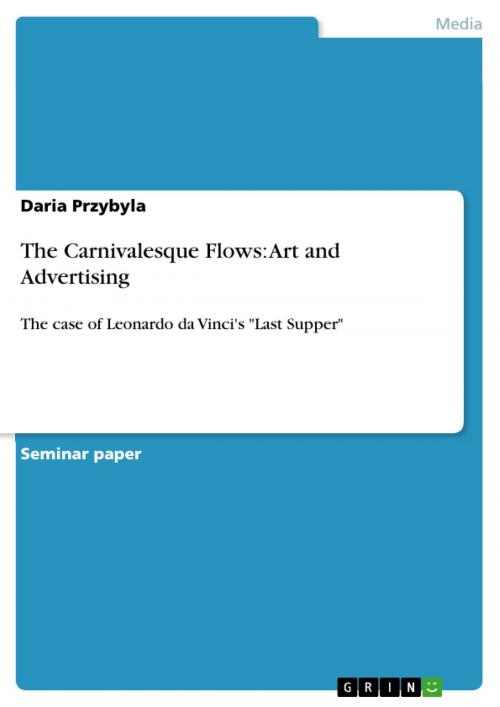The Carnivalesque Flows: Art and Advertising
The case of Leonardo da Vinci's 'Last Supper'
Nonfiction, Computers, Application Software, Computer Graphics| Author: | Daria Przybyla | ISBN: | 9783638808217 |
| Publisher: | GRIN Publishing | Publication: | July 7, 2007 |
| Imprint: | GRIN Publishing | Language: | English |
| Author: | Daria Przybyla |
| ISBN: | 9783638808217 |
| Publisher: | GRIN Publishing |
| Publication: | July 7, 2007 |
| Imprint: | GRIN Publishing |
| Language: | English |
Seminar paper from the year 2006 in the subject Art - Computer Art / Graphics / Art in Media, grade: A, University of Silesia, 4 entries in the bibliography, language: English, abstract: Bakhtinian conception of the carnivalesque is very complex in the sense that it opens a way toward a more general depiction of the nature of art in the relation to the repressed instincts of humans. Even though the idea is situated mostly in medieval and renaissance context, it can be easily transported and/or observed in contemporary popular culture. The theme that I intend to elaborate on is a mode of public relations encoded in media advertising and communicated via visual representations that extends far beyond hegemonic policies. There are two issues that should be pinpointed with respect to the subject matter. First, the master-narratives of culture and religion, as will be illustrated in the following argument, prove to have each a different relationship with the elements of the carnivalesque. And second, as we shall see, the clash between the religious 'high', sanctified art and the 'low' by-product of social development results in a tension between competing discourses. Consequently, the dialogic interaction within the framework of popular culture between the religious and the cultural reinforces import of the carnivalesque. The following essay concentrates on the case of Leonardo da Vinci's Last Supper and the way in which the painting has been used in popular culture along with an analysis of reasons for controversies arising around such cultural practices.
Seminar paper from the year 2006 in the subject Art - Computer Art / Graphics / Art in Media, grade: A, University of Silesia, 4 entries in the bibliography, language: English, abstract: Bakhtinian conception of the carnivalesque is very complex in the sense that it opens a way toward a more general depiction of the nature of art in the relation to the repressed instincts of humans. Even though the idea is situated mostly in medieval and renaissance context, it can be easily transported and/or observed in contemporary popular culture. The theme that I intend to elaborate on is a mode of public relations encoded in media advertising and communicated via visual representations that extends far beyond hegemonic policies. There are two issues that should be pinpointed with respect to the subject matter. First, the master-narratives of culture and religion, as will be illustrated in the following argument, prove to have each a different relationship with the elements of the carnivalesque. And second, as we shall see, the clash between the religious 'high', sanctified art and the 'low' by-product of social development results in a tension between competing discourses. Consequently, the dialogic interaction within the framework of popular culture between the religious and the cultural reinforces import of the carnivalesque. The following essay concentrates on the case of Leonardo da Vinci's Last Supper and the way in which the painting has been used in popular culture along with an analysis of reasons for controversies arising around such cultural practices.















